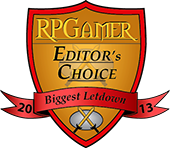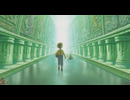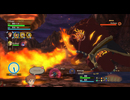
Biggest Letdown

Second Place

Third Place

|
It pains me in some ways to be the one writing this as someone who originally had this game on her most anticipated list on numerous occasions, but Ni No Kuni was not what I expected it to be. The feelings of wanderlust and adventure, though there, never captured my sense of childhood in the way I had hoped. There was something about this gorgeously dull world that failed to connect with many of the staff members, though a few would argue otherwise. It's hard to ignore the pointless White Witch arc that feels tacked on, or the fact that the players are smarter than the cast of characters.
It has an interesting hybrid combat system that features capturing mechanics... that only work a small percent of the time. Many plot situations are resolved through the use of Scooby-Doo tactics, and much of the narrative feels forced, yet isn't tightly woven together. I feel as though if the story had been written by Studio Ghibli and not Level-5, there is a good chance that its telling would have been a strength, but instead this game slathers the cheese and charm to excessive degrees. Charm is a huge part of Ni No Kuni's shtick but the reality is that charm can only take you so far, regardless of how solid a foundation may be. Ni No Kuni may have been the most polarizing RPG of 2013, but for our staff it was a massive disappointment.
It's not that Shin Megami Tensei IV is a bad game, more that it contains a collection of features that drag it down from being as good as we expected it to be. We've been longtime fans of this series, but SMTIV drops the ball in ways that turn the series' strengths into weaknesses. The characters are more like unchanging, walking philosophies than people, and it doesn't help that AI companions have a habit of wiping out the party via poor spell selection during boss battles. The game also wins our award for the worst overworld map we've seen in years.
Most disappointing, however, is the effect that the new combat system's balance has on the game as a whole. Allowing both the player's party and its enemies to store up extra turns by exploiting elemental strengths and weaknesses sounds like a neat twist on paper and was implemented well in past SMT titles. In practice here, however, the game is brutally hard at the beginning and too easy once the player has built up a nice collection of demons. This has the effect of driving off newcomers to the series and boring veterans, giving the game a veneer of disappointment for both groups of gamers.
When playing Project X Zone, one's first reaction is likely to be giddiness that the game crossed the Pacific at all, followed by joy at the rush of characters and references to titles from the companies involved. The high of playing with this goofy mix of characters lasts a substantial amount of time, but Project X Zone keeps going long after the initial rush fades. At that point we start to wonder why every character controls in pretty much the same way, and why the game seems to go out of its way to exemplify the stereotype in certain JRPGs that villains get up without a scratch constantly after the most abrasive pounding possible. There isn't much to do differently except mix and match supporting characters in the hope of getting interesting conversations going, because the battles play out the same throughout the game. Project X Zone demonstrates the unfortunate fact that sheer length is not always a good thing if the gameplay cannot support it.



by Sam Marchello, Becky Cunningham, Mike Moehnke
|









